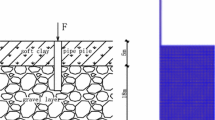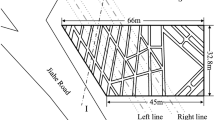Abstract
The permeability coefficient of soil mass will vary with the change of effective stress when a foundation pit is excavated in soft soil area. A three-dimensional fluid-solid coupling program was developed that can consider the change of permeability coefficient of soil with the effective stress by introducing the relationship between the permeability coefficient and the effective stress increment of soil. The foundation pit of Shanghai Bank Building in Lujiazui, Pudong District, Shanghai, China was simulated and the numerical results were compared with the ones without considering the change of permeability coefficient of soil. It is shown that the trend of the horizontal displacement of retaining structure is consistent whether or not the permeability coefficient of soil varies. The results considering the change of permeability coefficient of soil with the effective stress, however, are smaller and agree better with the measured results. As for the heave of pit base, the deformations considering the change of permeability coefficient are smaller than the results without considering it. However, the ground settlements around the pit considering the change of permeability coefficient of soil are contrary to the heave of pit base and they are bigger than the results without considering it. Therefore, the change of permeability coefficient of soil with the effective stress should be considered in excavation engineering of soft soil area.
Access provided by CONRICYT-eBooks. Download conference paper PDF
Similar content being viewed by others
Keywords
1 Introduction
In excavation engineering of soft soil, seepage and deformation are usually concurrent and interactive, seepage can cause the change of pore water pressure and effective stress, and further lead to the deformation of soil; and vice versa, deformation of soil also causes the change of permeability coefficient and influences stress of soil through pore water pressure. Therefore, many related researches have been made [1,2,3,4]. However, The variation of permeability coefficient of soil with the effective stress of soil mass is seldom considered. Therefore, it has important guiding significance to study the deformation behavior of an excavation considering the change of permeability coefficient with stress. In this work, to consider the variation of the permeability coefficient of soil with effective stress, a 3D finite element program [5] was further developed by introducing the relationship between the permeability coefficient and the effective stress increment of soil.
2 Relationship Between Permeability Coefficient and Effective Stress
The permeability of soil influences the permeability coefficient and variation of effective stress of soil affects the permeability of soil, therefore, the variation of effective stress of soil will result in the variation of the permeability coefficient of soil. With the effective stress increasing, the porosity and permeability of soil will decrease. There are some methods to determine the relation between the permeability coefficient of soil and other parameters and here is the relation between the permeability coefficient and the effective stress increment:
where k0 is the initial permeability coefficient of soil, k is the permeability coefficient of soil considering the variation of effective stress, p′ is the effective stress increment and a is a constant. As for the soil in Shanghai area, a = 7.16 according to the average experiment results of Wu and He [6]. Since the example is in Shanghai in this paper, a = 7.16 when determining the soil parameters.
3 Numerical Simulation of Excavation Considering the Variation of Coefficient of Permeability
3.1 Engineering Example
Shanghai Bank Building is located in Lujiazui, Pudong, Shanghai, China. The main structure consists of a 46-storey main building and a 3-storey podium building. The excavation depths of main building and podium building are 17.15 m and 14.95 m respectively, and excavation area is 7454 m2. Due to large excavation depth, high construction difficulty and high protection requirement of the surrounding, the diaphragm wall of 1000 mm thickness was adopted as retaining structure in order to decrease the horizontal displacement of retaining structure. Three tier supports of reinforce concrete were set and their cross-sectional dimensions at the first tier, the second tier and the third tier were 900 mm by 700 mm, 1300 mm by 700 mm and 1300 mm by 700 mm, respectively. Table 1 details the construction procedure of deep excavation of Shanghai Bank Building.
3.2 Numerical Model
Considering the influencing scope of an excavation, the symmetry about the center line and the calculation efficiency, an unit was taken in y-direction of excavation. Finite element meshes of numerical model are shown in Fig. 1 and the dimensions of the model in x- and z-direction are 100 m (length) by 80 m (depth).
As to the hydraulic heads inside and outside the excavation, they were assumed to locate on the excavation surface and the ground surface, respectively.
The soil constitutive model adopts the revised Duncan-Chang nonlinear elastic model [7] and the model parameters are listed in Table 2. In Table 2, K is the modulus number, n is the modulus exponent, Rf is the failure ratio, Kur is the unloading-reloading modulus number, D, F and G are material parameters, c′ and φ′ are the effective cohesion and the effective internal friction angle of soil, respectively, k is the permeability coefficient of soil (vertical and horizontal permeability coefficients are the same), and H is the thickness of soil layer.
Boundary conditions include displacement boundary condition and hydraulic boundary condition. As for the displacement boundary condition, the model bottom was assumed to be fixed, the model surface was free, and displacements perpendicular to the boundaries were restrained at the lateral boundaries. As for the hydraulic boundary, the model bottom, the symmetrical plane and the diaphragm wall were impermeable, whereas the model top was permeable.
Figure 2 is the comparison of horizontal displacement between the calculated results considering the variation of permeability coefficient and the measured results. It can be seen from Fig. 2 that the calculated values considering the variation of permeability coefficient and the measured values are in good agreement.
4 Result Analysis
4.1 Horizontal Displacement of Retaining Wall
Figure 2(a)–(c) also shows the comparisons of horizontal displacement considering the variation of permeability coefficient and without considering it after each excavation intermission. It can be seen from Fig. 2 that the horizontal displacements of retaining structure considering the variation of permeability coefficient are smaller than the ones without considering it. Take the fourth excavation intermission for example, the maximum displacement without considering the variation of permeability coefficient is 15.1 mm bigger than the one considering it. However, the horizontal displacements considering the variation of permeability coefficient are closer to the measured values than the ones without considering it.
4.2 Heave Deformation of Pit Base
Figure 3(a)–(c) indicates the comparisons of heave deformation of pit base after each excavation intermission. It can be seen from Fig. 3 that the change trend of heave deformation is the same after each excavation intermission. However, the values without considering the variation of permeability coefficient are much bigger than the ones considering it. Take the fourth excavation intermission, for example, within 30 m from the center of excavation the heave value considering the variation of permeability coefficient is approximately 4.3 cm, whereas the one without considering it is approximately 7.3 cm.
4.3 Ground Settlement Around Foundation Pit
Figure 4(a)–(c) are the comparisons of ground settlement around the pit after each excavation intermission. As can be seen from Fig. 4, the trend of ground settlement around the foundation pit in two cases is the same after each excavation intermission. However, the result without considering the variation of permeability coefficient is smaller, the difference of settlement and the influence range in two cases both becomes bigger and bigger.
5 Conclusions
Based on the actual excavation of Shanghai Bank Building, a program was developed considering the coupling of seepage field and stress field, and was verified through the comparison of the calculated horizontal displacements of retaining wall and the measured values. The conclusions from this study can be summarized as follows:
-
(1)
Whether or not considering the variation of permeability coefficient, the change trend of the horizontal displacement of support structure is the same. However, the horizontal displacement of support structure considering the variation of permeability coefficient with the effective stress of soil is smaller the one without considering it and the former is closer to the measured value than the latter.
-
(2)
The change trend of heave of pit base is also the same whether or not to consider the variation of permeability coefficient. However, the result without considering the variation of permeability coefficient is bigger than the one considering it.
-
(3)
After each excavation intermission, the trend of ground surface settlement around the foundation pit is the same whether to consider the change of the permeability coefficient or not. However, the result without considering the variation of permeability coefficient is smaller.
References
Meris, G., Rokhsar, A.: Theory of consolidation for clay. J. Geotech. Eng. Div. 8, 889–904 (1974)
Tavenas, P., Jean, P., Leblond, P., et al.: The permeability of natural soft clays. part II: permeability characteristics. Can. Geotech. J. 20(4), 645–659 (1983)
Osaimi, A.E., Clough, G.W.: Pore-pressure dissipation during excavation. J. Geotech. Eng. ASCE 105(4), 481–498 (1979)
Fan, Y.Q., Liao, X.H., Li. X.K.: Transient analysis of braced excavation in elastic-plastic saturated/unsaturated soils and parametric study. In: Proceeding of 9th International Conference on Computer Methods and Advances in Geomechanics, pp. 258–264 (1997)
Li, Y.Q.: Studies on the behavior of foundation pit with excavation considering seepage. Zhengjiang University, Hangzhou (2005). (in Chinese)
Wu, L.G., He, Z.G.: Considering the groundwater seepage of aquifer parameters with stress changes. J. Tongji Univ. 23(6), 281–287 (1995). (in Chinese)
Potts, D.M., Zdravkovic, L.: Finite Element Analysis in Geotechnical Engineering: Theory. Thomas Telford Limited, London (1999)
Author information
Authors and Affiliations
Corresponding author
Editor information
Editors and Affiliations
Rights and permissions
Copyright information
© 2018 Springer Nature Singapore Pte Ltd.
About this paper
Cite this paper
Li, Y., Fan, J., Zhou, X. (2018). Deformation Behavior of Foundation Pit Considering the Variation of Permeability Coefficient of Soil Mass. In: Qiu, T., Tiwari, B., Zhang, Z. (eds) Proceedings of GeoShanghai 2018 International Conference: Advances in Soil Dynamics and Foundation Engineering. GSIC 2018. Springer, Singapore. https://doi.org/10.1007/978-981-13-0131-5_41
Download citation
DOI: https://doi.org/10.1007/978-981-13-0131-5_41
Published:
Publisher Name: Springer, Singapore
Print ISBN: 978-981-13-0130-8
Online ISBN: 978-981-13-0131-5
eBook Packages: Earth and Environmental ScienceEarth and Environmental Science (R0)








